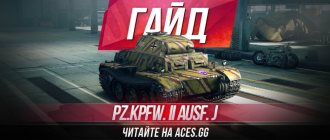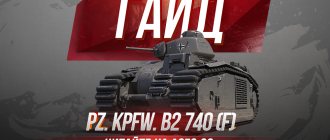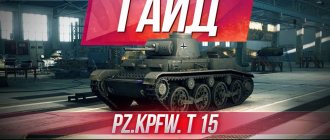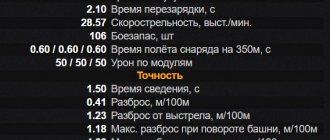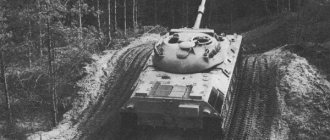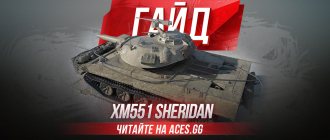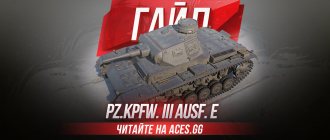Good day everyone and welcome to aces.gg! Friends, today we are focusing on another guest from the sandbox, a German light premium tank of the second level, in front of you is the Pz.Kpfw. II Ausf. D guide.
This unit is a gift and was given to everyone in 2014 on New Year's Eve, so you cannot buy it. I want to say right away that our guest does not have any distinct strengths. However, find out Pz.Kpfw. II Ausf. D characteristics will not hurt those who left it in the hangar or like to have fun with war games in the sandbox.
Tactics
If we compare this tank with its counterpart from the research tree, Pz.Kpfw. II, it becomes obvious that the Pz.Kpfw. II Ausf. D is seriously inferior to it in many respects.
Pz.Kpfw. II has a significantly higher power density, a turret with 30 mm of frontal armor and a faster-firing and more penetrating gun.
The only advantage of the Pz.Kpfw. II Ausf. D essentially consists only of a large margin of safety and a high maximum speed (which, however, it develops very reluctantly).
Tower Pz.Kpfw. II Ausf. D has weak armor and can be penetrated by any first-level machine gun; because of this, this tank is not able to effectively “tank” machine-gun tanks with its forehead, as the Pz.Kpfw does. II.
In close combat, it is necessary to act carefully, exposing the “machine gunners” first to the frontal part of the hull, into which they will unsuccessfully shoot the magazine.
At a long distance, the tank becomes completely useless due to the huge dispersion of the gun, which does not allow targeted shooting from a long distance.
Not to mention the drop in the already weak armor penetration. The only way you can help the team in this case is to play the role of passive light.
Advantages and disadvantages
Well, we managed to analyze the general characteristics of the tank, examined in detail the parameters of its armament, but for completeness of perception it is still worth dotting the i’s, that is, highlighting the main advantages and disadvantages of the Pz. II G WoT
, breaking them down point by point. Pros: • Excellent maximum speed and maneuverability; • Decent camouflage; • Very high penetration rates; • Comfortable vertical aiming angles. Cons: • Mediocre booking; • Poor mobility due to low dynamics; • Small alphastrike; • Long reloading of the drum and poor DPM; • Disgusting accuracy (spread, stabilization, convergence).
Historical reference
Pz. Kpfw. II Ausf. D - high-speed modification of Pz. II to equip light divisions created on the basis of cavalry ones. The tank had a completely new hull and chassis, and the turret and weapons were borrowed from the Ausf. C.
The chassis included eight large-diameter dual road wheels with individual torsion bar suspension without support rollers.
Tanks with reinforced suspension elements and new drive and guide wheels were designated Ausf. E. According to various sources, 200-250 vehicles of modifications D and E were produced.
New in blogs
The T-34 tank was by far the best tank of the war from the very beginning, but it had some shortcomings that made it weaker than it seemed at first glance. In the leadership of the USSR there was a long debate about the advantages and disadvantages of this or that technology and its capabilities in comparison with German models.
At the end of the 1930s, a unique opportunity presented itself to compare German and Soviet models, as several German tanks were purchased. So we conducted comparative shows.
TESTS The first such comparative test was carried out in 1940.
Then the Pz.Kpfw.III tank, purchased in Germany, arrived in Kubinka near Moscow for testing. It was tested both separately and in comparison with domestic tanks - and the results were not very flattering for the latter, including for the wheeled-tracked undercarriage, which was specially designed for high-speed driving deep into Germany along the first-class German autobahns:
German T-3 tank Tank building historian M. Svirin writes about this as follows:
“On a measured kilometer of gravel highway on the Kubinka - Repish - Krutitsy stretch, the German tank showed a maximum speed of 69.7 km/h, the best value for the T-34 was 48.2 km/h, for the BT-7 - 68.1 km/ h. At the same time, the testers gave preference to the German tank due to better ride quality, visibility, and comfortable crew positions.”
The T-34 performed well, although the BT was the fastest, but its armor was weak and it broke down more often. The only thing in which the T-34 was superior to the German was the gun, but this advantage was crossed out by the rest of its numerous shortcomings
T-34 model 1940 As we can see, the Germans had no particular reason to envy the unsurpassed speeds of the Soviet “highway” tanks. With regard to the chassis, the situation was rather exactly the opposite. And, alas, not only the chassis, but also the radio... “... Radio station In addition to report No. 0115b-ss To study the operating features of the German tank transceiver radio station, it was decided to practically compare it with the one available in the spacecraft on the BT-7 tank (The same as on the T-34. - Author's note). To do this, a tank unit consisting of a German tank and a BT-7 tank was removed by radio commands from the communications center at the test site, where the necessary measurements were carried out... Report No. 0116b-ss was drawn up on the progress of these tests, which, together with the dismantled radio station, was handed over to Comrade. Osintsev... I have to briefly report the following: The radio station of the German tank provides reliable two-way telephone communication in motion and in the parking lot, including at the maximum distance specified by the manufacturer... The operator was able to communicate by telephone even at a distance, 30 percent. exceeding the maximum range, while the radio station of our tank at the maximum distance provides only reliable reception. The transmission range on our tank is significantly reduced compared to the passport data... A positive quality of the German tank's transceiver station is also that it provides reliable communication while on the move, while while the BT tank is moving, the reception quality deteriorates significantly until the connection is completely lost... In all main characteristics, the radio station of a German tank is superior to that installed on a domestic tank. I consider it advisable to develop a new type of tank radio station based on existing German models... And in the same report, to describe communication support using a Soviet radio station, the optimistic phrase “with incredible efforts” is used... We think many readers have heard the phrase at least once: “The Red Army is strong, but communications will destroy it.” In the wars of the 20th century, and not only in them, communications are primarily the controllability of troops. And without control, military formations simply fall apart... Even in 1936, M. Tukhachevsky considered that the army did not really need walkie-talkies and it was better for the army headquarters to be located directly... in the air. From there, looking through the window, division commanders and army commanders would point their fingers and direct actions troops...such idiocy was no longer to be found in 1940.
The statement of the fact “while the BT tank is moving, the quality of reception deteriorates significantly, up to a complete loss of communication” meant that after the start of the battle, the Soviet tank commander lost control of his unit - if on the march it is still possible to wave flags, then after the start of shooting, each tankman will see only a narrow strip of land in front of you. If an anti-tank gun suddenly appears in this stripe firing, the crew will duel with it one on one - he will have practically no chance to “scream out” to his fellow soldiers walking nearby. ABOUT THE ARMOR OF A GERMAN TANK Finally, the tests came to the most important thing - the armor.
And the armor of the German tank also turned out to be an unexpectedly “tough nut to crack.” Here is what tank forces historian M. Svirin writes:
“...As you should know, shelling tests of a new German tank carried out in the fall of 1940 showed that to combat it, a 45-mm anti-tank gun mod. 1937 is unsuitable, as it is capable of penetrating its armor at a distance of no further than 150–300 m...”
Combined with intelligence reports that the Germans were strengthening the armor of the three-ruble gun and rearming it with a more powerful gun, the picture emerged bleak. The Soviet 45-mm cannon could no longer be a reliable weapon against German tanks; it did not penetrate their armor at a long distance, limiting itself only to close combat. It is worth noting that the tank’s armor was constantly being improved. The relatively low hull of the tank was welded from rolled armor plates. On modifications A-E, the frontal armor had a thickness of 15 mm, on modifications F and G it was 30 mm, on modification H it was reinforced with additional sheets up to 30 mm + 20 mm, and on modifications J-O it was already 50 -mm+20-mm. Tests of serial T-34s in November - December 1940 added tar to the already not very clean ointment.
“As a result of live firing with the solution of fire missions, shortcomings were identified: 1) The cramped conditions of the crew in the fighting compartment due to the small dimensions of the turret along the shoulder strap. 2) Inconvenience of using ammunition stored in the floor of the fighting compartment. 3) Delay in transferring fire due to the inconvenient location of the turret rotating mechanism (manual and electric drive). 4) Lack of visual communication between tanks when solving a fire mission due to the fact that the only device allowing all-round visibility, the PT-6, is used only for aiming. 5) Inability to use the TOD-6 sight due to the overlap of the aiming angle scale with the PT-6 device. 6) Significant and slowly damping vibrations of the tank when moving have a negative effect on the accuracy of firing from a cannon and machine guns. The noted shortcomings reduce the rate of fire and cause a large expenditure of time to solve the fire problem. Determining the rate of fire of a 76 mm cannon... The resulting average practical rate of fire is two rounds per minute. The rate of fire is insufficient...
CONTROL OF FIRE FROM THE TANK AND CONVENIENCE OF USE OF SIGHTS, SURVEILLANCE DEVICES AND AMMUNITION Rotating mechanism of the turret (manual). The turret is rotated with the right hand. The location of the flywheel and the rotating mechanism handle does not ensure rapid rotation of the turret and causes severe hand fatigue. When simultaneously operating the rotating mechanism and observing through the PT-6 device, the flywheel and control handle rest against the chest, making it difficult to quickly rotate the turret. The forces on the rotating mechanism handle increase greatly as the turret roll angle increases and significantly complicate the operation... Electric drive of the turret rotating mechanism. Access to the starting flywheel of the electric drive is difficult from below by the electric motor housing, on the left by the viewing device and the tower housing, on the right by the forehead and the PT-6 device. Rotation of the turret in any direction is possible only if the head is deviated from the forehead of the PT-6 device, i.e. the rotation of the turret is actually carried out blindly... Telescopic sight TOD-6. The window of the aiming angle scale of the telescopic sight is blocked by the terrain angle lever of the PT-6 device... Installation of aiming data is possible at elevation angles of 4–5.5 degrees and 9–12 degrees, which actually makes it impossible to fire with the TOD-6 sight. The aiming angle scale barrel is located in the middle part of the sight and is extremely difficult to access. Periscope sight PT-6. At an elevation angle of 7 degrees and below, up to the maximum descent angle, access to the handle of the all-round viewing mechanism is possible with only three fingers due to the fact that the sector of the gun’s lifting mechanism does not allow the handle to be covered by the hand. The specified position does not provide a quick view of the area. All-round viewing device.
Access to the device is extremely difficult and observation is possible in a limited sector to the right up to 120 degrees... The limited viewing sector, the complete impossibility of observation in the rest of the sector and ... an uncomfortable position of the head during observation makes the viewing device unsuitable for use. Tower viewing devices (side). The location of the viewing devices relative to the observer is inconvenient. The disadvantages are significant dead space (15.5 m), a small viewing angle, the inability to clean the protective glass without leaving the tank, and a low location relative to the seat. Driver's viewing devices... In the practical work of driving a tank with a closed hatch, significant shortcomings of viewing devices have been identified. When driving on a polluted dirt road and virgin soil for 5–10 minutes, the viewing devices become clogged with dirt until visibility is completely lost. The windshield wiper of the central unit does not clean the protective glass from dirt. Driving a tank with the hatch closed is extremely difficult. When firing, the protective glass of the viewing devices bursts...
The driver's viewing devices are generally unusable. All PT-6, TOD-6 sighting devices installed on the tank and observation devices in the fighting compartment and control compartment are not protected from precipitation, road dust and dirt. In each individual case of loss of visibility, it is possible to clean the devices only from the outside of the tank. In conditions of reduced visibility (fog), the PT-6 sight head fogs up after 3–5 minutes until visibility is completely lost. Ease of use of ammunition. Ammunition for 76 mm cannon. Stowing cartridges in cassettes does not provide a sufficient rate of fire for the following reasons: 1) Inconvenience of removing cartridges from cassettes. 2) Access to cartridges located on the left side along the tank is extremely difficult. 3) It is difficult to place cartridges in cassettes due to the presence of a large number of covers (24 pcs.) and rubber gaskets between the cartridges. The time spent on stowing a full load of ammunition is determined to be 2–2.5 hours. 4) Lack of sufficient packing density of cartridges in cassettes, leading to self-unscrewing of spacer tubes and cartridge case primers. 5) The presence of sharp edges of the cassettes, causing injuries to the loader’s hands. 6) Contamination of ammunition after a run of 200–300 km in the autumn period reaches a significant level. Using a full load of ammunition is possible only after preliminary cleaning of all cartridges. Ammunition for DT machine guns. When firing machine guns, the following shortcomings were identified: 1) Heavy contamination of the magazines in the control department. 2) Dust on the protruding parts of the magazines placed in the niche of the tower. 3) The impossibility of using ammunition without first cleaning it from contamination. 4) Removing individual magazines in the tower niche is difficult due to their jamming during installation. Convenience of workplaces and lighting of the fighting compartment. The seats of the turret commander and loader are large in size. The seat backs do not provide a comfortable position for the body, take up a lot of space and do not prevent clothes from getting into the turret shoulder strap (loader's seat). During live firing, the loader's seat makes it difficult to remove cartridges, hampers movement and touches the side stowage of ammunition. This situation is aggravated by significant crowding of the crew in the control department... A common disadvantage of the L-11 artillery systems installed in tanks is:
a) Failure to operate the trigger mechanism... b) The loader is not protected from impacts by the bolt handle when the semi-automatic is triggered. c) Unreliability in the operation of the foot trigger, which allows, in case of untimely and incomplete removal of the toe from the trigger pedal, jamming of the trigger slider and failure of the artillery system... ... Conclusion. The installation of weapons, optics and ammunition stowage in the T-34 tank do not meet the requirements for modern combat vehicles. The main disadvantages are: a) Crowded fighting compartment; b) Tank blindness; c) Unsuccessfully authorized stowage of ammunition. To ensure the normal location of weapons, firing and observation devices and the crew, it is necessary to: Expand the overall dimensions of the turret. For the 76-mm gun: Replace the trigger mechanism shield with a more advanced design that ensures trouble-free operation. Enclose the bolt handle with a shield or make it foldable. Remove the foot trigger, replacing it with triggers on the handles of the aiming mechanisms. For the DT machine gun: Provide the possibility of separate firing from a machine gun connected to the cannon. Increase visibility and shooting accuracy of a radio operator’s machine gun by installing an optical sight... For aiming mechanisms and sights. The turning mechanism (manual) is not suitable. Replace with a new design that provides little effort and ease of operation... Position the trigger mechanism for the electric drive of the turret rotation so that it provides rotation while simultaneously monitoring the terrain. Replace the TOD-6 telescopic sight with a TMF type sight with a scale of aiming angles in the field of view of the device. According to viewing devices. Replace the driver's viewing device, as clearly unsuitable, with a more advanced design. Install a device in the turret roof that provides all-round visibility from the tank. On stowing ammunition. Stowing ammunition for a 76-mm cannon in cassettes is unsuitable. The cartridge stack should be positioned so that there is simultaneous access to a number of cartridges...
Armored body. Conclusions. The tank hull and turret in this design are unsatisfactory. It is necessary to increase the size of the turret by increasing the shoulder strap and changing the angle of inclination of the armor plates. The useful volume of the hull can be increased by changing the chassis suspension and eliminating the side wells. Means of communication. Conclusions.
The installation of the radio was performed unsatisfactorily for the following reasons: The antenna, when lowered, is not protected from damage in any way... The design and location of the antenna lifting mechanism handle does not ensure reliable lifting of the antenna. The receiver's umformer is mounted under the radio operator's feet, the current-carrying terminal is damaged and the umformer becomes dirty. The receiver is mounted too low and far from the radio operator, making it difficult to configure. The power supply connectors for the radio (new type) are inconvenient to use - they have many protrusions that cling to clothing and injure your hands... The installation as a whole does not ensure stable operation of the radio over extremely long distances. Performance indicators and reliability of tank components. Tank dynamics. In difficult road conditions, when switching from 2nd to 3rd gear, the tank loses inertia so much during the shift that this leads to a stop or prolonged slipping of the main clutch. This circumstance makes it difficult to use 3rd gear in road conditions that fully allow its use. In conditions of rainy autumn, spring and snowy winter, this drawback of the tank leads to a sharp decrease in driving speeds on country roads and off-road... Conclusions. Due to the fact that the 3rd gear, which is most necessary in military operation conditions, cannot be fully used, the dynamics of the tank as a whole should be considered unsatisfactory. Technical speeds are low, which is due to the unreliability of the main clutch and chassis. Patency. Conclusion. The cross-country ability of the T-34 tank in autumn conditions is unsatisfactory for the following reasons: The surface of the track that engages with the ground is not sufficiently developed, which results in the tracks slipping on inclines even with slight wet cover. The effectiveness of the included spurs is negligible. The fixation of the caterpillar in the support wheels is unreliable... The small number of support wheels negatively affects the maneuverability in wetlands, despite the low overall specific pressure. Reliability of operation of tank units. Engine, fuel, lubrication, cooling systems and control devices. Conclusions. Engine reliability within the warranty period (100 hours) is satisfactory. The engine warranty period, especially for this heavily armored vehicle, is short. It is necessary to bring it to at least 250 hours. Constant oil leaks and failure of control devices characterize the operation of the lubrication system and connections of control devices as unsatisfactory. Main clutch. The operation of the main clutch and fan assembly is generally unsatisfactory.
Gearbox. During the run, cases of “loss of neutral” (the rocker lever is in the neutral position and the speed is on) and difficult gear shifting were repeatedly noted on all vehicles... Incorrect choice of gear ratios of the gearbox causes unsatisfactory dynamics of the tank and reduces its tactical value. Difficult gear shifting and “loss of neutral” make it difficult to control the tank and lead to forced stops. The gearbox and its drive require fundamental changes. Chassis. The short service life and low adhesion qualities of the tracks, the deterioration of the placement of tank units in suspension wells, the high consumption of rubber on support wheels and ridge engagement characterize the structural and strength qualities of the chassis as unsatisfactory. Electrical equipment. The ST-200 starter and RS-371 relay, due to existing installation and manufacturing defects, are not suitable for installation on T-34 tanks. Stowage of spare parts, tools, personal belongings, food supplies and special equipment. The stowage of spare parts, tools, personal belongings, food supplies, engineering and chemical equipment on the T-34 tank has not been worked out.”
As can be seen from the extensive quote above, the then “users” of the future “legendary thirty-fours” did not share the optimism of their descendants regarding “stronger than all of them combined.” Particularly in this sense, paragraph “c” is “pleasant” - about the impossibility of using the tank in isolation from repair bases. Considering the situation with spare parts and the level of mastery of new tanks by personnel, this actually meant that an entire tank factory had to follow the tanks going on the offensive.
THEY TRIED TO RECLASSIFY T-34 In a report prepared in 1940, “The State of Tank Armament and the Need to Create New Classes of Tanks,” the author, an engineer at the Leningrad Experimental Mechanical Engineering Plant No. 185 Koloev, indicated that,
“...considering, based on practical data; that guns with an initial [projectile] speed of about 900 m/sec penetrate armor [thick] 1.6 of their caliber,” the 45-mm armor of the T-34 tank will reliably protect it from shells of anti-tank guns and anti-tank rifles with a caliber of up to 25 mm. At the same time, “events in Finland showed that armor 45 mm thick at close ranges can be penetrated by a 37 mm anti-tank gun, not to mention 45 mm and 47 mm anti-tank guns, which can easily penetrate such armor at all main distances »
On this basis, Koloev proposed classifying the T-34 tank as a lightly armored tank, protected only from fragments, small arms fire, heavy machine guns and anti-tank rifles with a caliber of no more than 20–25 mm, and to assume that
“The T-34 tank with an armor thickness of 45 mm at close ranges cannot conduct a successful fight with 47 mm anti-tank artillery, therefore it does not correspond to its intended purpose, caused by an insufficiently clear understanding of the state of modern anti-tank artillery and an insufficiently substantiated approach to solving this issue »
The casket, alas, opens in a primitively simple manner: the invulnerability of the latest types of tanks to enemy anti-tank weapons turns out, alas, to be just a widespread myth. The question of the degree to which the armor of our tanks matches the enemy’s anti-tank weapons was raised even before the war.
CONCLUSION At one point, the amount of negativity about the T-34 became so great that there was a demand from NGOs and manufacturers to remove the T-34 from production. It’s not a joke to remove it, because by the end of 1940 the T-34 disappointed almost everyone, including the country’s top leadership. The T-34 lost trials to the German T-3 tank; it was considered simply a defective model with many shortcomings that could no longer be corrected.
The last word was with the country's top leadership; there were strong fluctuations on this issue, but still prudence prevailed. No one could have imagined that the disappointing T-34 would become the best tank of the war, a symbol of victory, in just a few years. .
Crew training
The training of tank crews sitting inside self-propelled guns must be given special attention, because only by making the right choice can you significantly improve your position on the battlefield. At the same time, it is undesirable to make mistakes here, because correcting them will take a lot of time and effort. Thus, for the Art-SPG Sturmpanzer II the perks
It is preferable to study in the following sequence: • Commander (radio operator) – , , , . • Gunner – , , , . • Driver mechanic - , , , . • Charger – , , , . • Charger – , , , .
Equipment for Sturmpanzer II
Another standard that almost never changes is the purchase of consumables. The bottom line is that if your supply of silver credits is running low, it would be better to carry , , . But in cases where saving is not necessary, it will be much safer to carry equipment on the Sturmpanzer II
from , , . By the way, you should know that our engine is located in the front, which increases the likelihood of fires, but if you play carefully, you can still replace the fire extinguisher with.
Equipment for Sturmpanzer II
By and large, the process of equipping artillery with additional modules is a foregone conclusion, because for this class of equipment there are only 3 most popular options. In our case, it is worth remembering about the open wheelhouse and the impossibility of installing equipment on the Sturmpanzer II tank
the following is installed: 1. – one of the most important and most popular modules, because it gives us the opportunity to shoot a little more often. 2. – an equally important addition to the machine, thanks to which the aiming process will become somewhat more comfortable. 3. – this option will increase your stealth while stationary, which will have a beneficial effect on survivability.
gun
Without further ado, it is clear that in terms of general characteristics this device is weak, but as it should be, the pride of artillery is its weapons, however, here, too, everything is not as good as we would like.
For starters, the Sturmpanzer II has a gun
, by the standards of other self-propelled guns-4, has a standard powerful one-time damage, but the rate of fire is unenviable, so in theory, you can deal about 1380 damage per minute.
Sturmpanzer II WoT penetration rates
received low ones, but thanks to the projectile’s hinged flight path, our land mines “enter” the enemy from above and in most cases the land mines cause very noticeable damage, and with the right amount of luck, classmates can be sent to the hangar with one shot.
It is also worth understanding that our land mines have a good radius of scattering fragments, and thanks to the large caliber of the gun, the Sturmpanzer II tank
can stun vehicles caught by our splash, temporarily reducing its characteristics.
From the point of view of accuracy, the news is disappointing, because the spread in our case is large, the convergence is long, and there is practically no stabilization at all, which is quite typical for artillery.
In terms of elevation and elevation angles, we have both good and bad news. The positive factor is that the Sturmpanzer II World of Tanks
became the owner of decent explosive weapons, the gun lowers by 4 degrees and rises by as much as 75, which is why we can “throw” our landmines over obstacles. But the UGN in our case is very inconvenient, because the gun rotates only 6.5 degrees in each direction, and this is very little.
